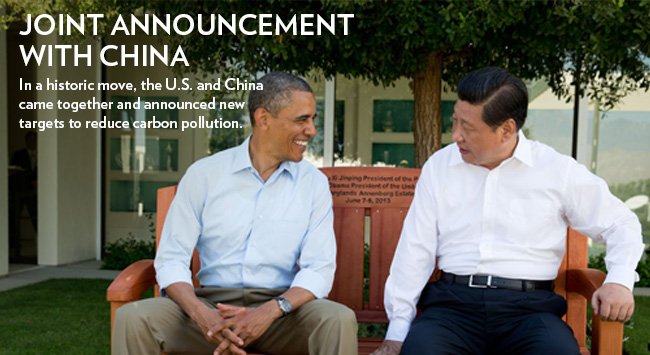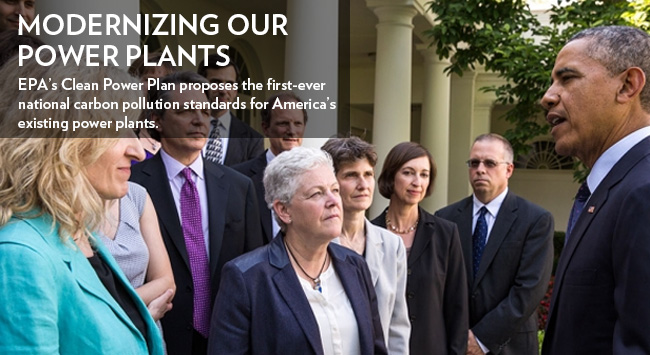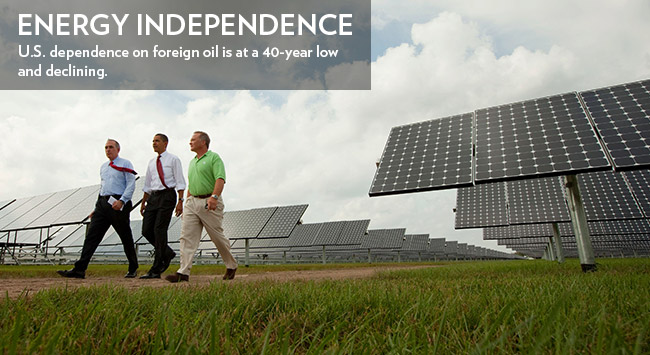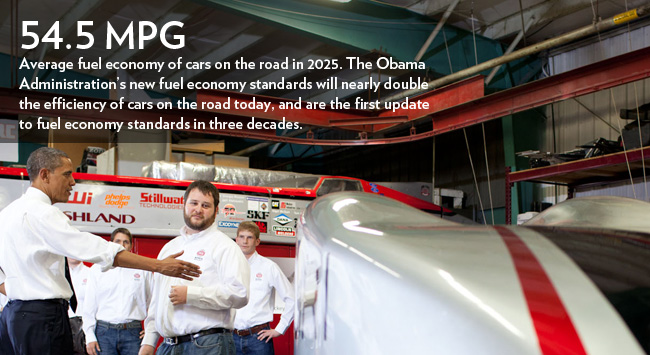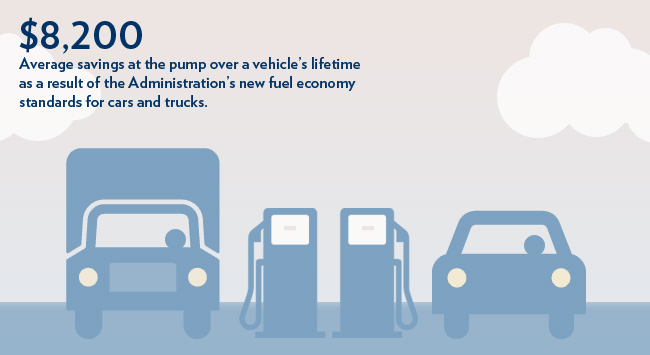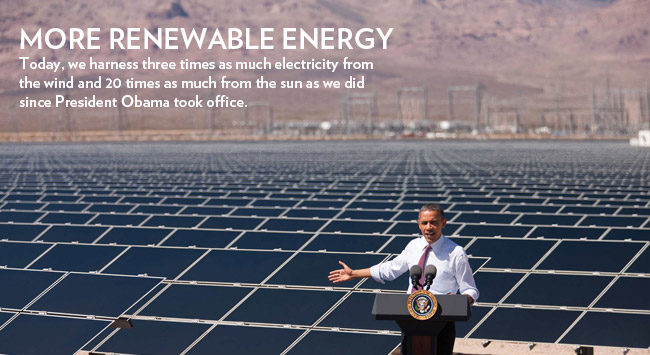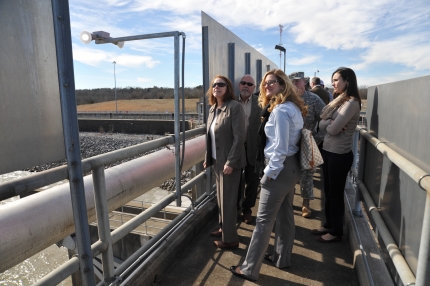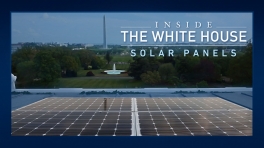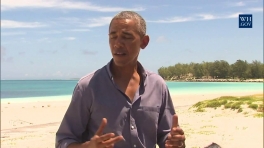Energy and Environment Latest News
We Must Act Now to Protect Our Winters
Posted by on January 28, 2015 at 4:27 PM EDT
Ed. note: This is cross-posted on the U.S. Environmental Protection Agency's blog. See the original post here.
2014 was the hottest year on record, and each of the last three decades has been hotter than the last.
In mountain towns that depend on winter tourism, the realities of climate change really hit home. Shorter, warmer winters mean a shorter season to enjoy the winter sports we love—and a financial hit for local economies that depend on winter sports.
Even if you hate winter, climate change affects you – because climate risks are economic risks. Skiing, snowboarding and other types of winter recreation add $67 billion to the economy every year, and they support 900,000 jobs.
Last week I went to the X-Games in Colorado to meet with some of our country’s top pro snowboarders and the businesses that support them to hear how they are taking action on climate.
Learn more about Energy and EnvironmentPresident Obama Protects Untouched Marine Wilderness in Alaska
Posted by on January 27, 2015 at 1:00 PM EDTToday, the President is taking another step to protect our most valuable natural resources. Relying on an authority used by presidents of both parties since Eisenhower, President Obama is designating 9.8 million acres in the waters of the Beaufort and Chukchi Seas off Alaska’s coast as off-limits to consideration for future oil and gas leasing. This action builds on recent steps by the President to protect Bristol Bay and the Arctic National Wildlife Refuge.
Teeming with biological diversity, these areas in the Beaufort and Chukchi are part of one of the last great marine wildernesses left untouched by development. Endangered whales swim through the icy seas, walruses and bearded seals feed on the Hanna Shoal, and more than 40 species of fish like cod and herring grant fishermen their livelihoods. Each year, the bowhead whale hunt draws Native communities throughout northern Alaska, as essential for their sustenance as it is to their way of life and cultural history.
Learn more about Energy and EnvironmentEnergy Efficiency Through Outdoor Lighting – What a Bright Idea!
Posted by on January 26, 2015 at 4:25 PM EDTOn Friday, the White House launched the Presidential Challenge for Advanced Outdoor Lighting, calling on local governments to accelerate the adoption and use of high efficiency outdoor lighting. In addition to driving carbon pollution reductions in communities across the country, the Challenge will help cities and states cut their outdoor lighting bills by 50% or more. And in the Federal Government, we’re committed to doing our part to improve lighting efficiency and save taxpayer dollars.
Last week, I toured the U.S. Army Corps of Engineers’ infrastructure improvement project along the Tenn-Tom waterway, an impressive feat of engineering that connects the Tennessee River in Alabama and the Tombigbee River in Mississippi. Using long-term energy savings to pay for up-front costs, the Corps’ Mobile District has embarked on a project to improve the Tenn-Tom waterway’s infrastructure. The project will install, replace, or retrofit elements along the waterway’s infrastructure, primarily focusing on the lighting fixtures at its 10 locks and dams. It’s the first-ever energy savings performance contract executed for a Corps civil works project and could set precedent for other Corps districts in utilizing third-party funding for future endeavors.
At first glance, swapping some light bulbs may seem like a small, unremarkable project. But improved lighting is actually one of the most straightforward and commonsense ways to improve energy efficiency. And the benefits are far from small: the Corps expects to save more than $5 million over the more than 20-year lifespan of the Tenn-Tom waterway contract. Beyond the energy cost savings, the improved outdoor lighting is also projected to cut greenhouse gas emissions by 941 metric tons each year.
Other Federal projects have yielded results that are just as impressive. The Army’s Ft. Irwin Rotational Units Maintenance Area recently replaced its inefficient lighting with higher-efficiency LED fixtures. The replacement lights have generated energy savings estimate at 75%, and will result in savings of over $87,000 per year. And the Department of Defense has demonstrated big savings and emissions reductions in other relighting projects and retrofits as well. Ultimately, these successes mean fewer tax dollars spent on energy bills and a reduced carbon footprint – a win-win for the American taxpayer and the environment.
As states and cities across the country answer the President’s call, the Federal Government will continue to lead by example in improving energy efficiency and cutting harmful carbon pollution.
Kate Brandt is Federal Environmental Executive at the White House Council on Environmental Quality.
Learn more about Energy and EnvironmentPresident Obama Calls on Congress to Protect Arctic Refuge as Wilderness
Posted by on January 25, 2015 at 12:00 PM EDTEach year, as the darkness of the Arctic winter brightens into spring, as the snow melts and the hills and valleys slowly turn green, the tens of thousands of members of the Porcupine caribou herd begin their great migration — traveling some 1,500 miles through Alaska’s Arctic National Wildlife Refuge to their calving grounds on the Coastal Plain.
This far northern region is known as “The Sacred Place Where Life Begins” to Alaska Native communities. The Refuge sustains the most diverse array of wildlife in the entire Arctic — home not only to the Porcupine caribou, but to polar bears, gray wolves, and muskoxen. Bird species from the Coastal Plain migrate to all 50 states of the country — meaning that no matter where you live, the Arctic National Wildlife Refuge is part of your landscape.
But the majority of the Refuge is not protected as wilderness, including the Coastal Plain. For more than three decades, some voices have clamored to drill for oil in the Coastal Plain — a move that could irreparably damage this ecological treasure and harm the Alaska Native communities who still depend on the caribou for subsistence.
Today, the Department of the Interior released a revised Comprehensive Conservation Plan to better sustain and manage the entire Arctic National Wildlife Refuge — and President Obama took it a step further and announced his plans to ask Congress to designate the Coastal Plain and other core areas of the refuge as wilderness:
Learn more about Energy and EnvironmentUnleashing Data and Tools to Boost Climate Resilience in India
Posted by on January 25, 2015 at 9:00 AM EDTLast September, at the UN Climate Summit in New York City, President Obama committed to work with partner nations to empower local authorities to better plan for the impacts of severe environmental changes such as drought, glacial retreat, flooding, landslides, coastal storm surges, agricultural stresses, and public-health-relevant challenges. As part of this commitment, he announced an interagency effort to, within one year, release higher-resolution elevation data for regions around the world – beginning with Africa. Datasets for the Caribbean, Mexico, and other regions have subsequently been made freely and publicly available.
Today, the Administration announced the release of the next tranche of higher-resolution elevation data for India. Until now, these elevation data for India were freely and publicly available only at 90-meter resolution. The datasets being announced today resolve to 30-meters and can be used to better assess and monitor the impacts of sea-level rise, conduct environmental monitoring activities, and support local resilience-relevant decision-making. These datasets are being made available on the U.S. Geological Survey’s Earth Explorer website.
Learn more about Energy and EnvironmentLaunching the Presidential Challenge for Advanced Outdoor Lighting
Posted by on January 23, 2015 at 2:46 PM EDTWe take it for granted that outdoor lights are there to help keep America moving after the sun goes down. But the outdoor lighting when you drive your car down the road at night, cheer for your favorite baseball team, or load groceries into your car after work uses energy and takes a bite out of budgets in cities and towns across the country.
Outdoor lighting in the U.S. will consume enough energy to power 6 million homes this year, costing cities about $10 billion annually.
That is why we are working with mayors to deploy the latest technologies to determine how best to light their cities while saving money. Using today's new technologies, local governments can cut their outdoor lighting bills by 50 percent or more. Today we are launching the Presidential Challenge for Advanced Outdoor Lighting, and tripling the DOE Better Buildings program goal of upgrading 500,000 poles to 1.5 million, to encourage more mayors to lead their cities with this win-win solution.
Learn more about Energy and Environment
- &lsaquo previous
- …
- 15
- 16
- 17
- 18
- 19
- 20
- 21
- 22
- 23
- …
- next &rsaquo
White House Blogs
- The White House Blog
- Middle Class Task Force
- Council of Economic Advisers
- Council on Environmental Quality
- Council on Women and Girls
- Office of Intergovernmental Affairs
- Office of Management and Budget
- Office of Public Engagement
- Office of Science & Tech Policy
- Office of Urban Affairs
- Open Government
- Faith and Neighborhood Partnerships
- Social Innovation and Civic Participation
- US Trade Representative
- Office National Drug Control Policy
